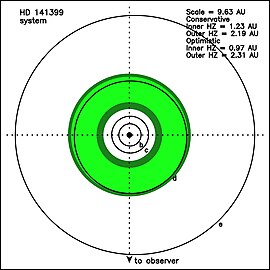Astronomy:HD 141399
Coordinates: ![]() 15h 46m 53.8135s, +46° 59′ 10.5407″
15h 46m 53.8135s, +46° 59′ 10.5407″
| Observation data Equinox J2000.0]] (ICRS) | |
|---|---|
| Constellation | Boötes |
| Right ascension | 15h 46m 53.8135s[2] |
| Declination | 46° 59′ 10.5407″[2] |
| Apparent magnitude (V) | 7.20 |
| Characteristics | |
| Evolutionary stage | main-sequence star |
| Spectral type | K0 |
| B−V color index | 0.73±0.04[3] |
| Astrometry | |
| Radial velocity (Rv) | -21.9±0.2[4] km/s |
| Proper motion (μ) | RA: -108.119[4] mas/yr Dec.: 6.040[4] mas/yr |
| Parallax (π) | 26.9888 ± 0.0146[4] mas |
| Distance | 120.85 ± 0.07 ly (37.05 ± 0.02 pc) |
| Details | |
| Mass | 1.09±0.08[5] M☉ |
| Radius | 1.46±0.15[6] R☉ |
| Luminosity | 1.59±0.39[6] L☉ |
| Surface gravity (log g) | 4.24±0.05[5] cgs |
| Temperature | 5602±34[5] K |
| Metallicity [Fe/H] | 0.36±0.03[5] dex |
| Rotation | 49±12[3] |
| Rotational velocity (v sin i) | 2.9±1.0[3] km/s |
| Other designations | |
| Database references | |
| SIMBAD | data |
HD 141399 is a K-type main-sequence star 121 light-years away in the constellation of Boötes. Its surface temperature is 5602 K. HD 141399 is enriched in heavy elements compared to the Sun, with a metallicity Fe/H index of 0.36±0.03.[5] Its age is unknown. The star has very low starspot activity.[3]
Planetary system
In 2014, four planets orbiting HD 141399 were discovered by the radial velocity method.[6] Planet HD 141399c is possibly located within the habitable zone.[3] The planetary orbits are close to high-order mean-motion resonance[7] and closely conform to Titius–Bode law. Two additional planets, one with a period of 462.9 days, are suspected by analogy with the orbits of the Solar System planets.[8] The planetary orbits around HD 141399 are expected to "jump" periodically on a timescale of a few million years between several quasi-stable configurations due to planet-planet interactions.[7] HD 141399 is one of only two known planetary systems consisting of at least four massive gas giants (the other is the system of planets around the young star HR 8799).[9]
| Companion (in order from star) |
Mass | Semimajor axis (AU) |
Orbital period (days) |
Eccentricity | Inclination | Radius |
|---|---|---|---|---|---|---|
| b | 0.451±0.030 MJ | 0.415±0.011 | 94.44±0.05 | 0.04±0.02 | — | — |
| c | 1.33±0.08 MJ | 0.689±0.02 | 201.99±0.08 | 0.048±0.009 | — | — |
| d | 1.18±0.08 MJ | 2.09±0.06 | 1069.8±6.7 | 0.074±0.025 | — | — |
| e | 0.66±0.10 MJ | 5.0±1.5 | 3370±90 | <0.1 | — | — |
References
- ↑ Kane, Stephen R. (2023). "Surrounded by Giants: Habitable Zone Stability within the HD 141399 System". The Astronomical Journal 166 (5). doi:10.3847/1538-3881/acfb01. Bibcode: 2023AJ....166..187K.
- ↑ 2.0 2.1 2.2 "HD 141399". SIMBAD. Centre de données astronomiques de Strasbourg. http://simbad.u-strasbg.fr/simbad/sim-basic?Ident=HD+141399.
- ↑ 3.0 3.1 3.2 3.3 3.4 3.5 Hébrard, Guillaume; Arnold, Luc; Forveille, Thierry; Correia, Alexandre C. M.; Laskar, Jacques; Bonfils, Xavier; Boisse, Isabelle; Díaz, Rodrigo F. et al. (1 April 2016). "The SOPHIE search for northern extrasolar planets. X. Detection and characterization of giant planets by the dozen". Astronomy and Astrophysics 588: A145. doi:10.1051/0004-6361/201527585. ISSN 0004-6361. Bibcode: 2016A&A...588A.145H. http://adsabs.harvard.edu/abs/2016A%26A...588A.145H.
- ↑ 4.0 4.1 4.2 4.3 Brown, A. G. A. (2021). "Gaia Early Data Release 3: Summary of the contents and survey properties". Astronomy & Astrophysics 649: A1. doi:10.1051/0004-6361/202039657. Bibcode: 2021A&A...649A...1G. Gaia EDR3 record for this source at VizieR.
- ↑ 5.0 5.1 5.2 5.3 5.4 Sousa, S. G.; Adibekyan, V.; Delgado-Mena, E.; Santos, N. C.; Andreasen, D. T.; Ferreira, A. C. S.; Tsantaki, M.; Barros, S. C. C. et al. (2018), "SWEET-Cat updated", Astronomy & Astrophysics 620: A58, doi:10.1051/0004-6361/201833350
- ↑ 6.0 6.1 6.2 Vogt, Steven S.; Butler, R. Paul; Rivera, Eugenio J.; Kibrick, Robert; Burt, Jennifer; Hanson, Russell; Meschiari, Stefano; Henry, Gregory W. et al. (2014), "A Four-Planet System Orbiting the K0V Star Hd 141399", The Astrophysical Journal 787 (2): 97, doi:10.1088/0004-637X/787/2/97, Bibcode: 2014ApJ...787...97V
- ↑ 7.0 7.1 Agnew, Matthew T.; Maddison, Sarah T.; Horner, Jonathan (2018), "Prospecting for exo-Earths in multiple planet systems with a gas giant", Monthly Notices of the Royal Astronomical Society 481 (4): 4680–4697, doi:10.1093/mnras/sty2509
- ↑ Allen, Christine; Cordero-Tercero, Guadalupe; Lara, Patricia (2020), "The reliability of the Titius–Bode relation and its implications for the search for exoplanets", Publications of the Astronomical Society of Japan 72 (2), doi:10.1093/pasj/psz146
- ↑ Staff, News (2023-10-31). "Giant Exoplanets Are Potential 'Agents of Chaos' in Multiplanet Systems, Astronomers Say | Sci.News" (in en-US). https://www.sci.news/astronomy/giant-exoplanets-12407.html.
 |


